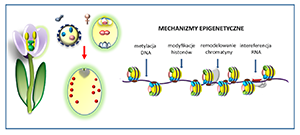Epigenetic mechanisms of sexual reproduction in Angiosperms
DOI:
https://doi.org/10.18388/pb.2021_418Abstract
Epigenetic mechanisms, such as DNA methylation, RNA interference, posttranslational histone modifications and rearrangements of chromatin structure play an important role during genome reprogramming in both animals and plants. The correct epigenetic pattern of eu- and heterochromatin marks allows for maintaining chromatin in an active or transcriptionally silenced state. In the life cycle of angiosperms, epigenetic mechanisms participate in genome reprogramming during: 1) differentiation of sporophyte cells into spore mother cells (SMC) that undergo meiosis, 2) development of female and male gametophytes, within which the gametes differentiate and 3) after double fertilization during the embryo and endosperm development. SMC speciation and control of meiosis, followed by reprogramming of the sperm cells and egg cell genome, are non-cell-autonomous and require RdDM pathway. These processes involve companion cells, which produce „mobile” siRNAs signal molecules. Epigenetic control of gene expression through siRNAs also participates in maintenance of gametes and embryo genome integrity and in the parental imprinting.

Published
Issue
Section
License
Copyright (c) 2022 Advances in Biochemistry

This work is licensed under a Creative Commons Attribution 4.0 International License.
All journal contents are distributed under the Creative Commons Attribution-ShareAlike 4.0 International (CC BY-SA 4.0) license. Everybody may use the content following terms: Attribution — You must give appropriate credit, provide a link to the license, and indicate if changes were made, ShareAlike — If you remix, transform, or build upon the material, you must distribute your contributions under the same license as the original. There are no additional restrictions — You may not apply legal terms or technological measures that legally restrict others from doing anything the license permits.
Copyright for all published papers © stays with the authors.
Copyright for the journal: © Polish Biochemical Society.



